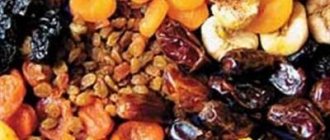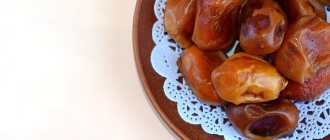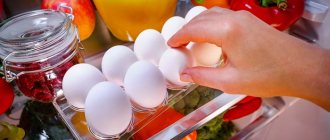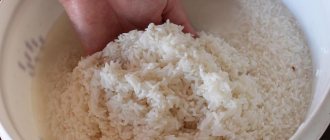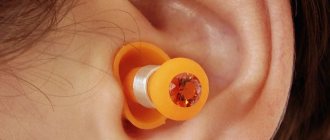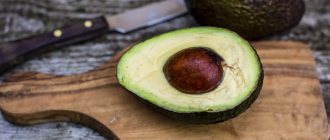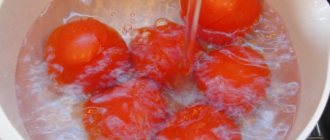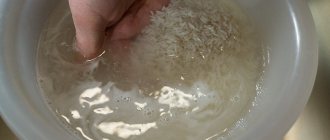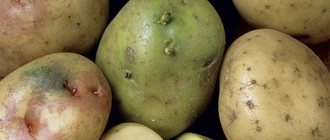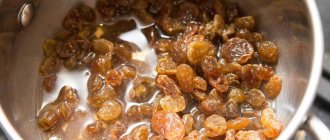How often do you wash dried fruits brought from the store? There are people who seriously don’t even understand why they need to be washed. This is the wrong approach. And some, concerned about the safety of their body, simply rinse them under running water. You can't do that either.
Let's talk about what needs to be done with dried fruits brought from the store so that they enter the stomach, being as safe as possible for health, and so that all the beneficial substances contained inside (and there are a lot of them) are well absorbed by the body.
How to wash dried fruits
Let's take a closer look at the question: how to properly wash dried fruits before eating?
In order to be absolutely sure that even a small dose of poison will not enter your body along with a healthy product, purchased dried fruits must not only be washed in water, but soaked. You will now learn how to soak dried fruits correctly.
Classic method of soaking fruits
It is worth highlighting three common methods of preparing dried fruits for consumption.
- Pour dried fruits with water at room temperature and soak for 30 minutes.
- Then rinse the fruits well with clean water.
- Pour cold water over the dried fruits for 10-15 minutes, stirring them periodically during the soaking period.
- Drain the water and rinse under running cold water.
- After this, rinse thoroughly with boiling water again.
Method No. 3 - for natural dried fruits
This method is suitable for fruits that are dried naturally.
In appearance, they will be less presentable and beautiful, since during the natural drying process they lose their texture and color. However, such dried fruits do not contain chemicals or harmful preservatives. Before use, it will be enough to rinse them well with warm water.
How to wash dried apricots
Are you wondering: do you need to wash dried apricots? Regardless of whether the fruits have been treated with sulfur dioxide or not, dried apricots need to be washed.
In most cases, dried apricots are treated with sulfur dioxide - outwardly they look clean, beautiful and very bright. However, to remove excess chemicals, more effort must be spent to properly wash the fruits.
First, soak the dried apricots for half an hour in water at room temperature. After this time, rinse it well under running water. Now everything is ready, and you can safely eat dried apricots.
Quite often, customers ask questions that concern them: “how to wash prunes and dried apricots” or “how to properly wash raisins and dried apricots” - it’s worth knowing that the washing methods for raisins and prunes are exactly the same as we used for dried apricots.
How to soak dried apricots correctly
Dried apricots need to be soaked in water at room temperature. The soaking time for the fruit is 30-40 minutes, or maybe longer - it depends on the softness of the dried apricots you prefer to eat. The longer it sits in water, the softer it will become.
How to properly wash raisins
Do you need to wash raisins? Of course, it needs to be washed, like any other dried fruit!
Properly washing raisins is not difficult. Soak the berries in warm water for 30 minutes, and after this time, drain the water and rinse with cold water.
How to wash dried prunes
The universal advice is this: be sure to wash all dried fruits, or even better, soak them in water before eating! To make prunes softer, you need to soak them for 30 minutes in hot water (but not in boiling water).
How to remove glycerin from prunes?
- Soak prunes for 60 minutes in water
20ºС;
then rinse well under running water.
How to wash figs
Do figs need to be washed? And Uzbek, Tajik, Uzbek and Turkish figs must be washed. Figs produced in Turkey need to be soaked and washed more thoroughly and longer than dried Tajik ones, because they are processed.
How to wash dates
Many people love dates for their excellent taste and benefits for the body. If you purchased these dried fruits at the market, you probably asked yourself the question of how to wash dates before eating and is it necessary to do so? The answer to this is unequivocal - dates need to be washed!
- we sort through the dates: exclude spoiled, too dry and damaged fruits;
- To rinse dates, you need to use a colander and a bowl of water at room temperature;
- fruits should be washed quickly and in small portions;
- Shiny dried fruits need to be washed especially carefully;
- Place the washed dates in a bowl into a colander and rinse well again under running cold water;
- To dry, use a paper or regular towel.
Sulfur dioxide in dried fruits
Note!
It is worth knowing that the most important preservative used for processing dried fruits is sulfur dioxide - this is a gas poisonous to human breathing; it is released when sulfur powder is set on fire. Preserving fruits using this method is called sulfitation.
How does it work? Dried fruits are sprinkled with sulfur powder on top and set on fire. As a result of the combustion process, a toxic gas with an unpleasant pungent odor is formed - sulfur dioxide. Breathing it is very dangerous and is strictly prohibited, as this gas can cause speech impairment, suffocation and pulmonary edema.
Is it really possible that healthy foods can slowly kill us? No, everything is not as scary as you might think at first glance. The fact is that sulfur dioxide is really harmful, but only if you breathe this gas; in the products themselves, its content is negligible.
The question arises, why is such a dangerous treatment used?
The thing is that dried fruits are a very perishable product and can be stored warm for only a short time. If you keep fruits in conditions unsuitable for this, then very soon rotting and spoilage may begin.
Sulfitation is a technology that perfectly protects dried fruits from rotting and harmful microorganisms. Thanks to this treatment, they do not darken over time, the appearance of the fruit is improved and preserved.
For example, sulfated dried apricots are beautiful, bright, appetizing, while natural dried apricots without processing are dark and wrinkled. If you want to eat fruits without unnecessary chemicals, when buying, do not chase a beautiful appearance, not everything beautiful is useful!
We conclude: since dried fruits are subject to chemical treatment, the answer to this question, whether dried fruits need to be washed, is unambiguous - dried fruits must be washed. Even if the fruits look clean and no particles of dirt and dust are visible on them.
Santa Claus or Santa Claus?
What is possible and healthy to eat during swelling?
Have you already fearfully directed your distressed gaze at homemade dried fruit? Very in vain! Yes, it is tatty, brown and dried at room temperature. But even this does not make it a particularly healthy food. The fact is that almost any fruit and vegetable contains enzymes that destroy vitamins. When storing a fruit (and a vegetable, too, by the way) at room temperature, these serial vitamin killers become active and destroy most of the beneficial content in the fruit. Therefore, fruits and vegetables, by the way, should only be stored in the refrigerator.
Table 1 shows average data on the destruction of vitamins during rapid drying in home dryers at low temperatures. And with slow drying and high-temperature drying, losses, accordingly, increase significantly.
Table 1
Typical Loss of Nutritional Benefits from Processed Foods Compared to Raw Foods
| VITAMINS | FREEZE | DRYING | BOILING, PRESERVATION |
| VITAMIN A | 5% | 50% | 25% |
| ALPHA CAROTENE | 5% | 50% | 25% |
| BETA CAROTENE | 5% | 50% | 25% |
| LYCOPINE | 5% | 50% | 25% |
| LUTHEIN + ZEAXANTHIN | 5% | 50% | 25% |
| VITAMIN C | 30% | 80% | 50% |
| THIAMIN | 5% | 30% | 55% |
| RIBOFLAVIN | 0% | 10% | 25% |
| NIACIN | 0% | 10% | 40% |
| VITAMIN B6 | 0% | 10% | 50% |
| FOLIC ACID | 5% | 50% | 70% |
| VITAMIN B 12 | 0% | 0% | 45% |
As you can see, most vitamins are stored in frozen fruits and vegetables. But if you leave fruits and vegetables to defrost at room temperature, then within a few hours most of the vitamins will also be attacked by “antivitamins” and will be destroyed. Therefore, it is better to bring the “scumbags” to an edible temperature in the microwave using a special “defrost” mode.
DRIED FRUITS: BENEFITS OR HARM?
Diet for gastritis: what you can and cannot eat and drink with such a diagnosis
In my articles, I have written many times that the healthiest thing for the body is a whole product in its original form - vegetables, fruits, nuts, seeds, greens... They contain the whole complex of substances necessary for the body - vitamins, minerals, fiber, water and thousands more substances called “phytocomponents”. Therefore, when we eat a whole product, we get the effect of the complex effect of absolutely all components of the plant on the body!
If you artificially remove one or more components of a plant, then it will be an inferior product and the body’s reaction to this product will be completely different. After all, when we eat food, a chain of chemical reactions occurs in the body. And, as we know from chemistry lessons, removing or adding just one substance completely changes the course of a chemical reaction. For this reason, the following are definitely harmful:
100% vegetable oils (everything except fats has been artificially removed). I wrote about them in an article about fats and oils. 100% refined sugar (everything except carbohydrates has been artificially removed)
I wrote about this in an article about sugar. 100% protein powder, no matter plant-based or not (everything except proteins is artificially removed). I wrote about this in an article about proteins. all pharmacy vitamins without exception (these are incomplete, only partially synthesized vitamins)
Read about this in the article about the dangers of pharmacy vitamins.
As for dried fruits, based on this logic, they are also inferior. But not to such an extent as to completely abandon them and consider them exclusively harmful. Let's go in order.
During drying, fruits lose an important component - water. Due to the lack of water in dried fruits, the concentration of sugar sharply increases to a level unnatural for the body. In fresh apricots, the sugar content, depending on the variety and ripeness, is 5-20%, and in dried apricots it is already 40-60%!
This leads to the following effects:
- A sharp jump in blood sugar after eating dried fruits. This puts stress on the pancreas, which is responsible for producing insulin, which in turn is responsible for maintaining normal blood sugar levels. To level out the sharply increased sugar level, the pancreas is forced to work harder.
- Reproduction in the body of yeast fungi, which are very fond of sweet environments. Any healthy body has these fungi, but in small quantities - along with our beneficial intestinal bacteria, they help the body digest and absorb food. But their growth contributes to the imbalance of the digestive system and the decline in the number of beneficial bacteria. Signs of this are bloating and gas formation after eating dried fruits. You've probably noticed these effects on yourself, I have) Especially when I eat prunes or figs!
- Dehydration of the body. Since dried fruits lack water, which is necessary for digestion and absorption, the body uses up its water reserves. This dehydrates us, increasing the concentration of toxins in our body. To maintain the required level of water in the body, we need to drink a lot of water. But not at the same time as dried fruits and not after 15 minutes. And about 40 minutes to an hour after eating dried fruits.
- Reproduction of bacteria in the oral cavity and the occurrence of caries. Dehydrated (dehydrated) foods are not good for your teeth. Extremely dry and sticky, they stick to the first wet surface they encounter—the teeth—and are broken down by bacteria. The highly acidic waste products of these bacteria land directly on the teeth and corrode the enamel.
How to remove oily shine from prunes
Almost all dried fruits are treated with sulfur dioxide to kill bacteria and prevent insects from eating them.
Then they are smoked in sulfur fumes to make them shine. To make prunes shine even more, they are lubricated with glycerin. The more shine, the more fat. Therefore, they must be at least soaked in cold water before use. It's better to scald with boiling water. Real dried fruits should be unsightly, inconspicuous, dry, and wrinkled in appearance. Colleagues from Uzbekistan once brought me a parcel with nuts and dried fruits. Everything in one package. A little dusty, probably because they contain nuts. There were a lot of sticks and some leaves. It all looked unappetizing. The nuts were rinsed, the dried fruits were soaked in hot water - everything was delicious and the taste was different. There is no such sweetness, everything is natural. True, instead of dried apricots there was an apricot with a tassel. In response to my question about dried apricots, my colleague frowned and said: “No, it’s not tasty for us, everything is processed and boiled in sweet syrup. the moderator chose this answer as the best
Prunes are sold dried, smoked and dried. I can’t tell you the technology for smoking and processing when smoking prunes, and there is not only one technology for this. It's the smoked prunes that shine.
more than a year ago
Dried apricots come across with a matte surface, but prunes shine like a glossy magazine cover.
Well, to attract the buyer’s attention so that he doesn’t pass by something black and dried)
Usually prunes had paraffin or sunflower oil for gloss, and its quality was not the best, otherwise prunes would have been even more expensive.
Now you can also find edible wax, carnauba, from palm leaves, but not in the cheap prune segment.
Without fiction, mineral oil can also be found on prunes.
Because it is assumed that the buyer will then wash the prunes, and will not eat everything that was processed, including sulfur dioxide.
Therefore, soak dried fruits for 15 minutes, rub each one, it’s large, convenient, and then eat.
more than a year ago
Indeed, when buying prunes, you can often notice that they are somehow greasy to the touch and have a characteristic shine, that is, everyone has come across such prunes at least once in their life. This indicates that it has been treated with chemistry, which helps it not to spoil for a long time, and the chemistry can be different; now most often they use a special gas, that is, they place the prunes in a special chamber and release this gas, which covers it like a film. Previously, ordinary paraffin or glycerin was used for these purposes. All this, of course, cannot be considered beneficial to health. Therefore, if you have already bought such prunes, you should rinse them in hot water to get rid of this. In general, you should pay attention to this when purchasing and it is better not to buy such prunes, but to look for one that does not have such shine and is not processed in any way. That is, prunes that are dull and lacking shine will be much healthier.
more than a year ago
If you dry prunes at home, using an oven or a special electric dryer, they will not be so soft and shiny. It is believed that dried plums should not stick to your hands. But when buying prunes, we see a different option.
The reason is that prunes are treated with glycerin. It adds shine, but does not have a distinctive smell, only a barely noticeable sweetish taste. Because of this, prunes should either be washed thoroughly, or even soaked in warm water and then washed.
Glycerin is not a breeding ground for the development of bacteria. Therefore, such prunes slowly deteriorate.
more than a year ago
Different sellers use different methods to make their product look more attractive to the buyer.
We all know that apples and oranges shine for a reason; they are specially treated with mineral or other oil.
Same with dried fruits.
But prunes are quite soft, when they are treated with oil, it penetrates into the skin of the product, the oil is not easy to wash off, and it oxidizes quite quickly.
But oxidized oil can already cause harm to health, in addition, the product will acquire an unpleasant rancid smell of spoiled oil.
So it is better to choose prunes with normal shine.
more than a year ago
Nowadays we often see how dried fruits or fresh apples and pears can shine very much, of course they look very appetizing.
But not everyone knows that prunes and other fruits are processed with glycerin.
It allows you to transport and store prunes without loss of quality.
Such prunes should be washed very well to remove glycerin. Or even soak it in hot water for several hours, and then rinse with running water.
Tips for storing capricious fruits
What can be prepared from fruits: a list of dishes, interesting recipes and cooking rules
Knowledge of the peculiarities of their preservation will help to extend the shelf life of “capricious” berries:
| Type of dried fruit | Storage Features |
| Prunes | Dried plums are stored at a temperature not exceeding +20 degrees Celsius for about 3 months. If the apartment is too hot, the berries are stored in the freezer. Paper or vacuum bags, glass containers are suitable for packaging. |
| Dried apricots, apricots | If possible, it is better to prepare dried apricots yourself. Such fruits have a lower percentage of moisture compared to factory-made ones. Dried apricots should be stored in a dark place, placed in a cloth package. However, long-term storage in bags will lead to excessive drying of dried apricots and the appearance of a white coating. Then the fruits are placed in the freezer. This will help preserve them for 2 years. Dried apricots are defrosted at a temperature of +20-23 degrees Celsius |
| Raisin | It is not advisable to place raisins in the refrigerator. It loves air, so it is preferable to place it in fabric bags made of cotton or linen. Glass containers are closed with paper instead of a lid. If the raisins dry out, sprinkle them with water and place them in the microwave for 1 minute. |
| Dates, figs | These fruits do not keep well at room temperature. It is better to put sweet drying in a vacuum bag, a container with a lid and place it in the refrigerator. Plastic bags are not suitable for this purpose. Supplies are not washed during preparation. The savings period will be 4 months |
Be sure to read:
How to store figs: 3 options and 5 recipes for storing and preparing
Do they need to be washed?
Large suppliers of nuts and dried fruits, who package them in individual packaging, usually carefully monitor the safety of their products. It is almost impossible to get an intestinal infection or be poisoned by pesticides after snacking on such nuts. It is better to wash dried fruits or nuts bought in bulk at the market before eating - this will not be unnecessary. The only arguments against may be a change in their organoleptic properties and a limited shelf life - after washing they should be eaten immediately.
WHY SOAK DRY FRUITS?
There are more than enough reasons:
— Dried fruit is dirty from the environment and the hands through which it passed during processing and delivery to the final destination. During soaking, the folds of the dried fruit are straightened out and the dirt is washed out of them, otherwise the dirt is practically inside the fruit.
— Perhaps your dried fruit has been processed in some way for safety and shelf life. Water removes almost any treatment. For example, when you smoke with sulfur, it settles on the fruit and cannot be washed off by simply washing it off, but during soaking, the sulfur rises to the surface of the water and then drains into the sink - you are left with the cleanest possible fruit.
— A dried fruit is a dried fruit that has been deprived of water. By removing water, we preserve the fruit for maximum time. When dried fruit lies in water, it takes water back, gets saturated and becomes softer, fleshier and juicier. Usually high-quality dried fruits: raisins, dried apricots, prunes and others are very dense due to drying and soak well. At the same time, soft dried fruits are most likely processed in some way and turn into porridge when soaked.
— It is more beneficial for our body to eat soaked dried fruits: the gastrointestinal tract perfectly accepts softer and ready-to-digest food, in contrast to food that is too hard.
— During soaking in dried fruits, the maximum amount of useful substances is activated!
— By pouring out the dirty water and soaking the fruits again in clean water, you can get a very healthy compote without cooking.
How to properly rinse dates
Many of us love dates for their taste and benefits. These dried fruits survive transportation well and can be stored well.
So, you bought them and are asking yourself the question of how to wash dates before eating? And is it necessary to do this at all? Looking ahead a little, we will answer - you need to wash dates before eating!
And before that, we will briefly describe the process of getting these overseas fruits onto your table:
- dates are collected from palm branches and dried (if they are not dried, they will not be able to reach us and be preserved)
- By the way, a whitish coating on dates (it is typical for dates) occurs precisely during the drying process
- There is another way to dry dates besides the natural one - drying in ovens (on an industrial scale) with further soaking in sugar syrup; such fruits can be distinguished by their characteristic shine and glossy surface
- after drying, they are packaged and sent to different countries around the world
Do not treat dates with boiling water! If this is done, their skin will crack and the flesh will “boil”, after which they will become unpalatable.
How to wash dates before eating
- Sort through the dates: exclude spoiled, overly dry and damaged fruits
- Use a bowl of cool water and a colander to rinse the dates.
- wash them quickly and in small quantities
- wash shiny dried fruits especially thoroughly
- Place the washed dates in a colander and rinse again under running cold water.
- To dry, use a regular towel or paper towel; you should also cover them with a towel on top
- dry overnight
Do I need to wash dried bananas?
Dried bananas are made from ripe, fresh bananas by drying them over charcoal at low temperatures. Most often you can find dried bananas from Vietnam or China.
Did you know that it takes 7 kg of fresh , ripe bananas to make 1 kg of dried bananas?
As in most cases, for packaged dried fruit there is a universal advice (read here) about rinsing before eating.
We suggest you simply pour boiling water over the dried bananas and dry them .
Clean conversation
In fact, if the fruits were dried in the sun, it is difficult to imagine how much dirt and sand they have accumulated. Yes, they are covered with gauze to protect them from insects or dried on verandas, but dust inevitably settles on them. Later, when they are carried in bags and displayed on shelves “by weight”, they attract insects and dust.
Such “wild” dried fruits need not just to be washed, but to be disinfected:
- Pour the treat in one layer into a wide bowl.
- Pour boiling water to completely cover the berries.
- Let stand and then drain into a sieve.
- Additionally, pour boiled water to wash away the remaining grains of sand from the opened folds.
What about packaged ones?
Packaging protects from dust, gases and other troubles, but only the finished product. Therefore, whether to wash it or eat it depends on how the product was produced. If these are cheap trays wrapped in film, it is likely that these are the same “wild” delicacies, simply packaged in a warehouse.
Factory-made goods with a full label (when produced and distributed on trays, composition, calorie content, expiration date, etc.) are more trustworthy. Ideally, it should also indicate whether the fruits are steamed or not, whether they need to be washed before eating, or whether this is unnecessary. Unfortunately, such information is most often not available.
Fruits and nuts in bagged and sealed packaging definitely do not require washing. They are included in the snack category and are tested as ready-to-eat products (doesn’t anyone wash bread or sausage?).
Nuts are not washable at all. If there is any concern about them, the kernels are calcined in the oven or in a frying pan, but peeled nuts usually end up in the package after the appropriate procedures.
So, dried fruits sold in bulk need to be washed, but those from factory packaging do not (unless sand, traces of mold or erosion are visible, otherwise it is better not to take the products or rinse them with boiling water).
Do I need to wash packaged dried fruits?
Photo: Dried fruits in packaging
This question can be answered only after you open the package (of course, it is better to choose dried fruits in transparent packaging in advance, then you can immediately determine whether to wash them or not):
- If you find that the dried fruits have a matte texture and there is no sand or other particles, it means that the manufacturer has already washed the dried fruits, they can be eaten!
- if the dried fruits have a bright color, they were processed in production; in this case, use the washing methods that we described above.
Preparing dried fruits for storage
Dried fruits that are purchased in stores and are factory packaged, as a rule, are stored well and do not cause any special problems. Although here a lot depends on the integrity of the manufacturer.
Self-dried fruits should be carefully prepared for storage:
- in the process of preparing for drying, cut the fruit into equal slices so that they dry evenly;
- While drying, stir the dried fruits periodically, removing spoiled ones, turning them over and removing the finished ones;
- before storing fruits, sort them carefully, removing those that look unpresentable, are not dried and are beginning to deteriorate;
- In the place where the fruit will be stored, place products that have a strong smell (mint, oregano, citrus fruits) to repel possible insects.
Rules for choosing dried fruits on the market
Most dried fruits supplied to the food market are treated with sulfur dioxide (SO2), which is designated on packaging as the preservative E220. This preservative prevents the development of microorganisms in dried fruits, allows them not to darken, in a word, it gives an appetizing appearance and greatly increases shelf life.
However, sulfur dioxide (E220) is a highly toxic compound. Sensitivity to sulfur dioxide poisoning varies from person to person. For example, after eating several pieces of dried apricots treated with sulfur dioxide, within a few minutes a sore throat and headache begin. Other people are less sensitive to this preservative.
Common symptoms of sulfur dioxide poisoning are:
- severe sore throat,
- runny nose,
- cough,
- hoarseness,
- headache,
- nausea.
In case of poisoning with high concentrations, suffocation and pulmonary edema may occur.
And although there are standards (maximum permissible concentrations) for the content of sulfur dioxide when processing various products, you must admit that you really want to avoid eating it. And it is quite possible to do this.
Removing sulfur dioxide from dried fruits is based on the good solubility of this substance in water. That is, it is enough to soak dried fruits in water at room temperature, while changing the water several times.
I soak it for 1 hour in one water, then rinse it well and soak it again for another half hour. After this, dried fruits lose most of their E220 and can already be eaten!
How to choose dried fruits without processing
To completely protect yourself from the effects of harmful chemical preservatives, you must try to choose the right dried fruits. It is best if they are not treated with chemicals.
How to choose dried fruits without preservatives and what to look for when purchasing:
1
Pay attention to the color. Apparently bright and unnatural colors: bright yellow (dried apricots), amber yellow (raisins) - indicate that these fruits were subject to chemical treatment
The bright colors of cherries, dried apricots, and raisins indicate that they are not worth buying
The apparently bright and unnatural colors: bright yellow (dried apricots), amber yellow (raisins) indicate that these fruits have been subject to chemical treatment. The bright colors of cherries, dried apricots, and raisins indicate that they are not worth buying.
When purchasing, you need to remember that high-quality, chemical-free dried fruits have a very unattractive appearance - they are wrinkled, dark with dust. These are the ones that are not treated with preservatives and can be bought with confidence.
Any dried fruits, before eating, should be soaked in water at room temperature for 10 - 15 minutes, and then rinsed well with running water.
2
Pay attention to taste and smell. If the fruits were dried naturally, they do not have the smell of smoke or the unpleasant taste of gasoline
When buying, you need to take a good sniff; if there are foreign, unpleasant odors, then you shouldn’t buy dried fruits; they were dried in an unnatural way - in gas or gasoline ovens. With such drying, all beneficial substances and vitamins are destroyed, and a harmful carcinogen settles on the cracked skin of the fruit. Severely cracked fruits are a defect
If the fruits have been dried naturally, they do not have the smell of smoke or the unpleasant taste of gasoline. When buying, you need to take a good sniff; if there are foreign, unpleasant odors, then you shouldn’t buy dried fruits; they were dried in an unnatural way - in gas or gasoline ovens. With such drying, all beneficial substances and vitamins are destroyed, and a harmful carcinogen settles on the cracked skin of the fruit. Severely cracked fruits are a defect.
Choose dates with pits, and prunes and raisins with stalks - these fruits retain beneficial vitamins and substances better than others.
3
Notice the strange shine. This problem occurs when choosing prunes
Unscrupulous sellers very often soak it in very low quality vegetable oil or treat it with glycerin. By these actions they give the fruits softness and an appetizing shine. If the prunes are coffee-colored, it means that they were scalded with boiling water, and this deprives them of their benefits and vitamins. Don't buy prunes that are too shiny. Published by econet.ru
This problem arises when choosing prunes. Unscrupulous sellers very often soak it in very low quality vegetable oil or treat it with glycerin. By these actions they give the fruits softness and an appetizing shine. If the prunes are coffee-colored, it means that they were scalded with boiling water, and this deprives them of their benefits and vitamins. Don't buy prunes that are too shiny. Published by econet.ru
What you should pay attention to
Sometimes when you soak or boil dried fruits, you may notice an oily film forming on the surface of the water. This means that the fruits you purchased were treated with oil or glycerin.
Such processing is done in order to give dried fruits a more beautiful appearance and more shine. In principle this is not dangerous. However, it is still worth being convincing and attentive when choosing dried fruits - because in this way, careless sellers try to hide the beginning of spoilage of the products from buyers.
The situation is much worse if, when soaking dried fruits, the water turns blue - this indicates that the fruits were treated with fungicides or dyes were used to improve their appearance.
This is important to know!
Remember, if the water turns blue when soaking the fruits, then it is not recommended to eat such dried fruits.
Do I need to wash dried cranberries?
It is very advisable to rinse dried cranberries!
- If it is in a package, then read here how to wash it before eating.
- If you purchase dried cranberries at the market or elsewhere, by weight, etc. wash it using one of these methods.
After washing, dry it - now you can use it.
How to cook dried fruit compote so that the drink turns out full of vitamins and tastes good
Nuts have many beneficial properties, but you should also be aware of the harm they can cause.
A light salad that can be prepared even in the cold season.
What is the difference between olives and olives, how are olives produced?
Learn how to choose dried fruits. What are their benefits and when can they cause harm?
Healthy lifestyle
Dried fruits, which can be found in large quantities on store shelves, can be not only unhealthy, but also dangerous to eat. It all depends on what drying method was used to obtain them.
The value and usefulness of dried fruits has been confirmed by many studies. Dried apricots, raisins, dates, figs, prunes contain many vitamins that are so necessary for our body and, especially, the heart.
All these valuable properties are preserved in “correct” dried fruits - dried fruits that have not been subjected to special treatment with toxic chemicals, including dyes. It is this fairly cheap method of quickly drying fruits, which allows you to save resources, significantly increase the shelf life of dried fruits and give them a “marketable” appearance, that is used to obtain the majority of dried fruits.
The safest and healthiest are only those dried fruits that were obtained in the traditional way - natural drying.
To obtain dried fruits, the following types of drying are used:
– drying in the sun. The fruits obtained in this way are hard, which is not the best option.
– drying in the shade allows you to get semi-soft fruits. Compared to sun drying, this is a better method.
– treatment with toxic chemicals (sulfur dioxide - sulfur dioxide, additive E220) and heat treatment. These dried fruits are the most common on sale. They have an attractive appearance, but they are unsafe for health.
This is one of the simplest and most affordable ways to obtain dried fruits. Firstly, sulfur dioxide treatment is much faster than natural drying. Secondly, after such processing the fruits remain soft, underdried and weigh more than ordinary dried fruits devoid of moisture. Thirdly, as a preservative, sulfur dioxide helps such under-dried dried fruits not to spoil. Sulfur dioxide kills bacteria, but it is also toxic to humans. Please note: dried fruits processed in this way are not eaten by pests!
The use of chemicals for “drying” allows even unripe fruits to be used. They are immersed in boiling water with sodium hydroxide (caustic soda). This causes the hard skin to crack and the fruit to dry more easily. And in order to kill bacteria that grow in cracks in the peel, fruits are treated with the same sulfur dioxide.
Another way to obtain dried fruits is through smoking with liquid smoke, an equally dangerous carcinogen. To add shine, the surface of dried fruits is treated with fat or glycerin.
After treatment with these and similar substances, dried fruits become shiny, their color intensifies - bright dried apricots, shiny prunes, golden raisins... Appetizing, but unsafe.
Such dried fruits should never be eaten unwashed. But even regular rinsing under running water will not be enough. In our body, sulfur dioxide under the influence of liquid turns into a weak solution of sulfurous acid, which irritates the mucous membrane of the digestive system, which over time can cause a number of diseases.
Two reasons why you need to wash dried fruits
The first reason is simple and probably understandable to many. No one knows what conditions dried fruits were in before they reached your table. Perhaps the dried half of a prune ended up on the floor somewhere, and an unscrupulous seller returned it to the general box? Or, for example, did someone take the fruits with their hands without gloves? It’s already clear that dried fruits need to be washed.
The second reason is known to those who understand at least a little about the production technology of this product. It is important to understand that store-bought dried fruits are not homemade ones that have been dried in the sun. To ensure a beautiful appearance and a long shelf life, the fruits are treated with preservatives (benzoate and potassium sorbate, as well as sulfur dioxide). These substances do not pose any particular harm to the human body, but before consuming the treat, it is still better to process it correctly.
So how to properly wash dried fruits? It is worth noting that each type requires a special approach. Let's figure out what it should be like.
By date of birth, you can calculate the optimal interior color for everyone
Miracle or legend: Samara local historians conducted an investigation into “Zoya’s Standing”
They have money and power: types of men prone to cheating in relationships
Exactly how much soda do you need?
Baking soda is one of the safest food disinfectants. Therefore, even exceeding the NaHCO₃ concentration indicated in the recipes above (up to 1 tablespoon per liter of water) will not cause harm to health. Of course, no one canceled the final rinse with water.
Soap solutions (laundry soap and dishwashing detergents) are washed off much less easily and can enter the body, causing indigestion, poisoning and other troubles.
It is no coincidence that store-bought products for processing vegetables and fruits, which claim to be environmentally friendly and safe for humans and the environment, often contain baking soda.
